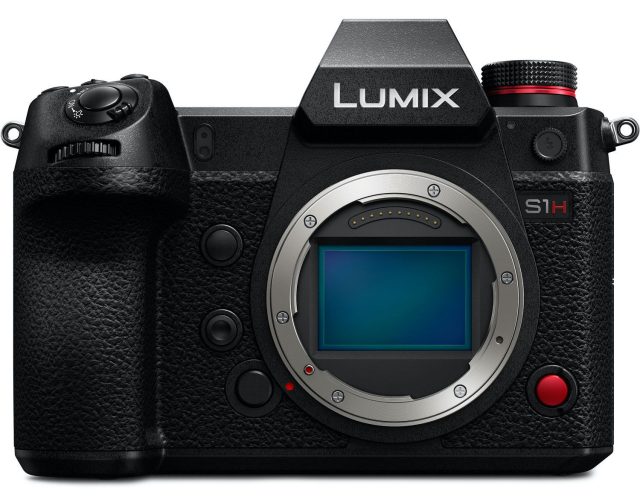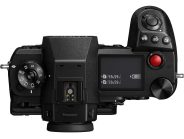Announced
Production status
System
Panasonic Lumix DC-S1H
35mm AF digital mirrorless camera
Specification
| Format: | |
| 35mm full frame | |
Imaging sensor: | 35.6 × 23.8mm CMOS sensor |
Resolution: | 6000 × 4000 - 24 MP |
Sensor-shift image stabilization: | Yes |
| Leica L [20mm] | |
| Shutter: | |
Type: | Focal-plane |
Model: | Electronically controlled |
Speeds: | 60 - 1/8000 + B |
| Exposure: | |
Exposure metering: | Through-the-lens (TTL), open-aperture |
Exposure modes: | Programmed Auto |
| Aperture-priority Auto | |
| Shutter-priority Auto | |
| Manual | |
| Physical characteristics: | |
Weight: | 1164g |
Dimensions: | 151x114.2x110.4mm |
Manufacturer description
Newark, NJ (August 27, 2019) – Panasonic is proud to announce the launch of the LUMIX S1H, a new Digital Single Lens Mirrorless camera equipped with a full-frame image sensor, combining professional-level video quality with the high mobility of a mirrorless camera. The LUMIX S1H is the world’s first camera capable of video recording at 6K/24p *1 (3:2 aspect ratio), 5.9K/30p (16:9 aspect ratio) and 10-bit 60p 4K/C4K *2 *3 an achievement previously revealed during development.
In addition to its long history developing cinematic cameras aligned with the film industry’s needs, Panasonic also launched and continues to improve the world’s first compact, lightweight, Digital Single Lens Mirrorless camera. Combining these innovative ideas resulted in the industry-leading LUMIX GH Series which proved that a digital still camera can record video in unprecedented high quality suitable filmmaking. Further integrating the potential of the full-frame sensor, Panasonic is proud to introduce the LUMIX S1H as the ultimate digital mirrorless camera packing its best possible performance.
A newly developed 24.2-megapixel full-frame image sensor complies with the new Dual Native ISO. In combination with the optimum signal processing by Venus Engine, it achieves high sensitivity while minimizing noise. The LUMIX S1H provides more than 14 stops of dynamic range, comparable to those found in cinema cameras, and V-Log / V-Gamut compatible with popular colorimetry called “VariCam Look.” Uniquely, the LUMIX S1H features unlimited recording time in all recording modes thanks to Panasonic’s unique heat dispersion technologies. HDR (High Dynamic Range) in HLG (Hybrid Log Gamma), 4:2:2 10-bit HDMI output and Anamorphic 4:3 modes are also available with a variety of practical tools for filmmaking, such as tally lights, a waveform monitor and a V-Log View Assist function.
The LUMIX S1H incorporates a Body I.S. (Image Stabilizer) to compensate for hand-shake movement. Combining the Body I.S. (5-axis) and the O.I.S. (Optical Image Stabilizer, 2-axis) in the LUMIX S Series lenses, the Dual I.S. 2 is even better positioned to compensate for virtually any type of blurring, allowing the use of a 6.5-stop*4 slower shutter speed. The new rear monitor, Real View Finder and Status LCD boast a large size, high resolution and high visibility. The rugged design creates an additional layer of attractive features, providing professional photographers with highly desired reliability and longevity.
With the launch of the S1H, Panasonic now offers three innovative models in the LUMIX S Series of full-frame Digital Single Lens Mirrorless cameras including the critically acclaimed the S1R and. The LUMIX S1 is ideal for taking high-resolution pictures, the LUMIX S1R is an advanced hybrid camera for high-quality photos and videos and the LUMIX S1H is designed and developed especially for film production. With this lineup, Panasonic proves its commitment to meeting the needs and satisfying the desires of every imaging professional, consistently pushing the limits of photo and /video culture in the modern digital era.
In addition, the LUMIX S Series full-frame mirrorless camera system adopts the L-Mount system to provide users with a diverse and future-proof range of products. More than 46 interchangeable lenses, including 11 or more LUMIX S/S PRO lenses, are available or will be available from Panasonic, Leica Camera and Sigma and a variety of mount adapters/converters further expands the range of lenses to choose from. This wide range of utilization is a testament to the L-Mount’s versatility, opening up an almost limitless spectrum of new creative possibilities.
*1 As a full-frame digital interchangeable lens system camera, as of August 27, 2019 (U.S.). Panasonic research.
*2 As a full-frame digital interchangeable lens system camera, as of August 27, 2019 (U.S.). Panasonic research. In Super 35mm-equivalent size.
*3 Corresponding to 4K (4096×2160) as defined by Digital Cinema Initiatives (DCI).
*4 Based on the CIPA standard [Yaw/Pitch direction: focusing distance f=105mm when S-R24105 or focusing distance f=200mm when S-R70200 is used.] Firmware must be updated to the latest version.
Cinema-quality video recording performance
Outstanding video recording capability is the hallmark feature of the LUMIX S1H, making it an ideal professional tool for filmmaking.
The S1H contains a 24.2-megapixel 35mm full-frame CMOS sensor (35.6 mm x 23.8mm) that captures 6K resolution. With an active resolution of 6,024 x 4,016, the S1H delivers approximately 24.2 million photosites. OLPF adoption (Optical Low Pass Filter) suppresses moiré. In combination with optimum signal processing by the Venus Engine, it assures maximum ISO 51200 high sensitivity recording with minimum noise.
The distinguishing feature of the LUMIX S1H is dual-native ISO sensitivity, technology first introduced in the flagship VariCam line-up. It utilizes a process that reads the sensor in a fundamentally different way, extracting more information without degrading the image. This results in a camera that can switch from standard sensitivity to high sensitivity with almost no increase in noise or other artifacts. Dual Native ISO gives cinematographers a greater variety of artistic choices as well as the ability to use less light on set, effectively saving time. The LUMIX S1H’s Dual Native ISOs are 640 and 4000*1, which allow cinematographers to shoot in virtually any lighting environment. With a single native ISO image sensor, normally, noise increases as sensitivity rises; however, the new image sensor with Dual Native ISO in the S1H minimizes noise generation by choosing an optimal circuit to use according to the sensitivity before gain processing. The result is a maximum ISO 51200 high sensitivity recording. This Dual Native ISO technology can be switched manually between LOW (ISO 640-5000) and HIGH (ISO 4000-51200). *1
Maximizing the use of the pixels in the full-frame image sensor, the LUMIX S1H, as a digital camera, achieves for the first time ever a 6K/24p, 5.4K/30p (3:2 aspect ratio) or 5.9K/30p (16:9 aspect ratio) high-resolution, smooth video recording. *2 It is also the world’s first full-frame digital interchangeable lens system camera*1 to enable 10-bit 60p 4K/C4K *3*4 HEVC video recording when using the image area equivalent to Super 35mm. The 4:2:2 10-bit 4K30p can record in H.264 at its full area. Its high-resolution data can also be used for creating 4K videos with higher image quality or for cropping images in 4K.
Dynamic range measures the luminance range that a digital camera can capture. The LUMIX S1H delivers more than 14 stops of dynamic range, which are virtually the same as those of the Panasonic Cinema Cameras, to precisely reproduce both dark and bright areas.
The ability to capture accurate colors and rich skin tones is essential for any filmmaker. With this in mind, Panasonic created the LUMIX S1H to import the renowned colorimetry of the VariCam lineup of cinema cameras. The LUMIX S1H contains V-Log/V-Gamut capture to deliver a high dynamic range and broad colors. V-Log renders a very flat image while maintaining all of the color information within the image, so there is a greater level of play when the images are processed in post-production. The CMOS sensor of the LUMIX S1H achieves a wide color gamut known as V-Gamut, which is the S1H’s optimum color space and achieves a color space that is wider than BT.2020. V-Log has log curve characteristics reminiscent of negative film, while V-Gamut delivers a color space even larger than film.
HDR (High Dynamic Range) video recording is an option, which reproduces both the bright and dark parts of an image, creating images identical to how they are perceived by the human eye. The camera records video with a designated gamma curve compatible with ITU-R BT.2100, and the user can now choose Hybrid Log Gamma (HLG) in Photo Style.
The LUMIX S1H is capable of 4:2:2 10-bit 4K 60p/50p HDMI output. It accommodates a variety of recording formats, including 4:3 Anamorphic mode, to meet professional needs.
The VFR (Variable Frame Rate) lets users record overcranked or undercranked video in C4K/4K (60 fps, maximum 2.5x slower in 24p) and FHD (180 fps, maximum 7.5x slower in 24p). The minimum frame rate for quick motion video is 2 fps. In addition, HFR (High Frame Rate) video with sound can be recorded even when using auto focus. A variety of effects are available for producing a slow motion video in post-production.
Practical tools like a Waveform Monitor and V-Log View Assist are also available. Tally lights are equipped on both the front and rear sides for use in a multiple camera setup.
*1 When recording mode is set to V-Log. The sensitivity varies depending on the recording mode.
*2 As a full-frame digital interchangeable lens system camera, as of August 27, 2019 (U.S.). Panasonic research.
*3 As a full-frame digital interchangeable lens system camera, as of August 27, 2019 (U.S.). Panasonic research. In Super 35mm-equivalent size.
*4 Corresponding to 4K (4096×2160) as defined by Digital Cinema Initiatives (DCI).
High reliability to support professional work
The LUMIX S1H integrates the Body I.S. (Image Stabilizer) for effective handshake correction. Panasonic developed an algorithm that precisely calculates shake information acquired from a gyro sensor, and image and accelerometer sensors. This enables more accurate shake detection and compensation, making it possible to use a 6-stop slower shutter speed*1. Combining the Body I.S. (5-axis) in the camera and the O.I.S. (Optical Image Stabilizer, 2-axis) in the LUMIX S Series lens, the 5-axis Dual I.S. 2 compensates for larger movements that were conventionally uncontrollable. Maximizing both O.I.S. and B.I.S. is highly beneficial in telephoto shots and in adverse situations, such as in low-light or with one-handed shooting with a 6.5-stop slower shutter speed*2. The 5-axis Dual I.S. 2 works for both photo and video recording, including 4K. The Body I.S. compensates for camera movement even when other L-Mount lenses without O.I.S. are used.
To achieve stable, continuous video recording, heat dispersion is crucial. Based on the accumulated study of heat simulation through the development of both professional cinema cameras and digital still cameras, Panasonic designed a cooling fan with an innovative structure that efficiently disperses heat exclusively for the LUMIX S1H to support its limitless video recording capability.
To be tough enough to withstand heavy field use, the main structure is composed of a magnesium alloy full die-cast top/front/rear frame. Robust construction and a sealing for every joint, dial and button make the LUMIX S1H not only splash-resistant*3 and dust-resistant*3 but also freeze-resistant down to -10 degrees Centigrade. The shutter unit is also durable for approximately 400,000 cycles.
The LUMIX S1H is equipped with a double SD Memory Card slot, compatible with the high-speed, high-capacity UHS-II and Video Speed Class 90. Users can flexibly choose the recording method from Relay Recording, Backup Recording or Allocation Recording which enables saving video and photo data in a separate card. The 7.4-V 3,050 mAh high-capacity battery achieves a long recording time of approximately two hours in all recording modes*4. The battery can be quickly charged via USB PD (USB Power Delivery) using the bundled USB3.1 Type-C cable, which also realizes high-speed data transfer.
*1 Based on the CIPA standard [Yaw/Pitch direction: focusing distance f=50mm, when S-X50 is used.]
*2 Based on the CIPA standard [Yaw/Pitch direction: focusing distance f=105mm when S-R24105 or focusing distance f=200mm when S-R70200 is used.] Firmware must be updated to the latest version.
*3 Dust and Splash Resistant does not guarantee that damage will not occur if this camera is subjected to direct contact with dust and water.
*4 When the battery is fully charged. The recordable time varies depending on the shooting condition and settings.
Expandability for creative freedom
The LUMIX S1H complies with 4:2:2 10-bit 4K 60p/50p HDMI output. For the terminal, an HDMI Type A is provided. Plus, a cable lock holder for the HDMI cable is included in the LUMIX S1H to prevent unplugging trouble on location.
The LUMIX S1H is also compatible with Time Code IN/OUT synchronization through the flash synchro terminal and bundled BNC converter cable with BNC cable. This makes non-linear editing of footage from multiple cameras easy.
A variety of accessories can be used for the LUMIX S1H in common with the S1R and S1 -- a Microphone Adaptor (DMW-XLR1), Remote Shutter (DMW-RS2), Eyecup (DMW-EC6), Battery Grip (DMW-BGS1), Battery Charger (DMW-BTC14) and more. The Microphone Adaptor is a plug-in adaptor for an XLR microphone to record high-quality stereo sound and is ideal for lip-sync recording. Dedicated switches allow direct, quick control between MIC, LINE and CONDENSER microphones. The Battery Charger also complies with USB PD and enables quick power charging in approximately two hours. The camera remains usable while charging via this adaptor. The conventional External Flash (DMW-FL580L / FL360L / FL200L) can also be mounted on the LUMIX S Series cameras.
Compatibility with Bluetooth 4.2 (called BLE: Bluetooth Low Energy) enables constant connection with a smartphone or tablet with minimum power consumption. The settings of a LUMIX S1H camera can also be copied and transmitted wirelessly to other S1H cameras when using multiple S1H cameras. Also, Wi-Fi 5-GHz (IEEE802.11ac)*1 is effective in addition to 2.4-GHz (IEEE802.11b/g/n). This provides secure and stable connection not only with a smartphone or tablet, but also with other devices on location for smooth remote control. The transmission speed of photo/video data is also increased by using the 5-GHz band*2. The LUMIX Sync application for iOS*2/Android*3 devices enables photo transmission to a smartphone or a tablet via easy wireless connection. It also allows remote control of the camera using these devices.
Application software LUMIX Tether enables tethered shooting. Users can control the camera by connecting it to a PC via USB, which lets them view the image on a large PC screen while shooting.
*1 5GHz Wi-Fi is not available in some countries.
*2 iOS is a trademark or registered trademark of Cisco in the U.S. and other countries and is used under license.
*3 Android and Google Play are trademarks or registered trademarks of Google Inc.
High operability for intuitive control
The LUMIX S1H employs three large, high-resolution display devices for smooth confirmation of images on the spot.
The 3.2-inch, 2,330K-dot in 3:2 aspect rear monitor features approximately 150 percent higher luminance compared with the LUMIX S1R/S1, GH5 and GH5S for high visibility in outdoor use. Adopting a new mechanical structure, it achieves both tilt and rotation movement so that users can easily change angles without unplugging HDMI, USB or other cables. Live View Boost is another practical feature that makes it possible to check the composition even in total darkness by boosting the sensitivity just for live view. It also incorporates a Night mode that provides mild backlighting and lets the user watch the subject comfortably, even immediately after viewing the monitor in a dark enviornment for a long time.
The LVF (Live View Finder) is the key factor for completing the ultra-high-speed response of the camera. The LUMIX S1H, as well as the S1R and S1boasts the world’s highest Real View Finder level of 5,760k-dot resolution.* The 0.78x magnification ratio can be switched to 0.7x or 0.74x according to the shooting situation. Adoption of a high-speed, high-precision OLED for the LVF achieves a smooth display at 60 fps/120 fps (switchable) and high-speed response with minimum lag time of approximately 0.005 sec as well as 10,000:1 high contrast for exceptional visibility. With minimum distortion and high optical performance, the Real View Finder provides a natural view as seen with the naked eye. It is consistently sharp and clear from the center to the corners.
The new Status LCD boasts the largest-in-class level of 1.8-inch size and high resolution. Adopting MIP (Memory In Pixel technology), it consumes minimum power and is ideal for always-on use, even when the camera power is off. It shows the recordable time for video, number of images and remaining battery with a black/white switchable background. It assures high visibility both in bright outdoor and in dark situations thanks to the reflective type of LCD with a backlight. Major settings for photo shooting or video recording are displayed. The response of the LCD is also fast enough for time code counting and audio monitoring.
The LUMIX S1H has multiple Fn buttons on its body front allowing quick access to the designated functions, as well as a touch control system. A sub video button is also situated on the front so that the user can reach the button from the left side. Most of the buttons can be customized to assign functions depending on usage.
* As a Digital Single Lens Mirrorless Camera, as of August 27, 2019.
High photo shooting performance as a digital camera
The LUMIX S1H captures both high-quality video and stunning still photos. It is capable of shooting images in 14-bit RAW format for precise reproduction of details.
Taking full advantage of its high-resolution sensor, the LUMIX S1H provides a High Resolution mode that faithfully captures even tiny details to be saved as beautiful, highly realistic RAW images. Eight consecutive images are automatically shot while shifting the sensor using the Body I.S. (Image Stabilizer) mechanism and synthesized into a 96-megapixel equivalent (12,000 x 8,000-pixel) image by the latest Venus Engine, which boasts high-speed signal processing. This mode is suitable for taking natural landscapes or fine arts with delicate details. This magnificently high-resolution photo is ideal for landscape photography of stationary subjects using a tripod. However, it can also be used in situations where moving subjects are included in the scene, by switching the sub mode.
Panasonic has achieved a high-speed AF with its advanced control technology over the major devices: lens, sensor and imaging engine. The lens and sensor communicate at a maximum 480 fps. Combining the Contrast AF with DFD technology, the LUMIX S1H realizes an ultra-high-speed, high-precision AF of approximately 0.08 sec*1. The LUMIX S1H also boasts high-speed burst shooting at 9 fps (AFS) or 6 fps (AFC). With its high subject tracking performance, it never loses the target subject. A camera that excels in low-light shooting, the LUMIX S1H boasts -6EV*2 luminance detection performance with Low Light AF thanks to the higher sensitivity and optimized tuning of the sensor. The face/eye detection technology makes it possible to capture people in crisp focus. The Eye AF even detects the pupil of the eye and precisely focuses on it for impressive portrait shooting. The LUMIX S1H also incorporates Advanced AI Technology that detects specific subjects - humans and fast-moving animals, including cats, dogs and birds. The camera continues tracking its subjects even when they turn their back to the camera.
For more continuous burst shooting, 6K PHOTO*3 makes it possible to capture unmissable moments at 30 fps by extracting the frame with the best timing out of a 6K burst file (in 4:3 or 3:2 aspect ratio) to save as an approximate 18-megapixel equivalent high-resolution photo. 4K PHOTO enables 60-fps high-speed captures in approximate 8-megapixel equivalent resolution. In 6K PHOTO/4K PHOTO, three exclusive mode options are available depending on the situation; 6K Burst/4K Burst, 6K Burst (Start/Stop)/4K Burst (Start/Stop) and 6K Pre-burst/4K Pre-burst. Users can choose the most suitable burst shooting mode in addition to the regular consecutive shooting mode in full resolution, depending on the situation.
With the HLG*4 Photo mode, Panasonic proposes a whole new style of photo expression It provides a wider dynamic range to reproduce light and shadow with more natural contrast. HLG Photos can also be produced as an HSP file*5 with compressed high-brightness signals in its full resolution (5,888 x 3,312, in 16:9, with the LUMIX S1H) in addition to JPEG/RAW files. It excels in the expression of lights, such as sparkling starlight or glaring sunlight. The user can play back these vibrant images on the latest Panasonic HLG-compliant 4KTV via HDMI cable connection or other HLG-compliant devices. It is also ideal for photo presentations by photographers.
The high-precision shutter unit offers the highest shutter speed at a maximum 1/8000 second to capture spur-of-the-moment, fast-moving subjects and to use a high-speed lens with a fully open aperture even outdoors for impressive defocusing. The external flash can be synchronized with the industry’s fastest shutter speed of a maximum 1/320 second.*6*7
The Highlight Weighted Light Metering Mode meters light with the priority on highlighted parts, to prevent them from washing out.
The S1H (body) will be available for $3999.99 at the end of September.
*1 11EV, at wide-end with S-R24105 (CIPA) in LVF120 fps setting.
*2 At ISO100, F1.4, AFS
*3 6K PHOTO’ is a high speed burst shooting function that cuts a still image out of a 4:3 or 3:2 video footage with approx.18-megapixel (approx. 6000 x 3000 effective pixel count) that the 6K image manages.
*4 “HLG (Hybrid Log Gamma)” is an international standard (ITU-R BT.2100) HDR format.
*5 “HSP” is an HDR picture format using HLG format video technology.
*6 The guide number decreases when the shutter speed is set to 1/320 of a second.
*7 As a Digital Single Lens Mirrorless Camera, as of August 27, 2019.




